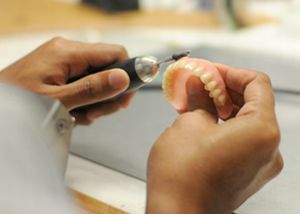 Good fixation of removable dental prostheses is an important part of their regular use. The relocation of the prosthesis is necessary every time the patient begins to experience discomfort during conversation and chewing.
Good fixation of removable dental prostheses is an important part of their regular use. The relocation of the prosthesis is necessary every time the patient begins to experience discomfort during conversation and chewing.
Its goal is to improve the fit of the structure and restore adequate jaw closure. In this case, the pressure transferred to the mucous membrane becomes more physiological and correct.
Contents
- When
- is not needed
- Clinical method
- Procedure in the
- laboratory Some features of the
- Used materials
Cases where
is not necessary without relocation
Relocation of dentures is necessary in such cases:
- defects in the design;
- change in the relief of the oral mucosa during immediate prosthetics or after a prolonged use of permanent prostheses;
- violations at the stages of prosthetics, for example, when removing impressions and casting gypsum models;
- changes the height of the lower third of the face.
Clinical method
This relocation method can be used directly in the dental office. It is based on the following stages:
- Check for bite, central occlusion and jaw movement. Areas of excessive baseline pressure on the underlying tissues are also determined.
- Evaluation of the correspondence of the prosthesis to the relief of the jaws.
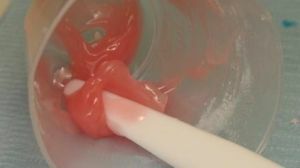
- Inspect the length of the edges and the degree of their volume. If they are too long, then they are shortened. Short, however, is increased with the help of fast-hardening plastic.
- After evaluation of all parameters on the inner surface of artificial teeth, a small layer of plastic is removed. The optimum thickness is 1 mm.
- At the edges of the prosthesis and its outer side, only the topmost layer is removed, which was polished. For this, a carborundum head is used.
- To prevent the plastic from adhering to artificial teeth, a layer of petroleum jelly is applied on them. They also isolate the mucous membrane of the oral cavity.
- Next, mix the plastic.
- At the stage of "stretching threads" plastic is applied to the entire surface of the structure with a uniform layer.
- After 10-15 seconds, the prosthesis is inserted into the oral cavity and pressed against the jaw. The patient is asked to close his teeth in the usual position.
- Next, the edges are simulated by active and passive movements.
- After 1-1.5 hours the prosthesis is removed from the oral cavity and placed in hot water. It is the final polymerization of plastic.
- At the end, the doctor checks to see how well the mucosal relief has been reflected. All surpluses are removed by milling cutters, and the inserted teeth are polished.
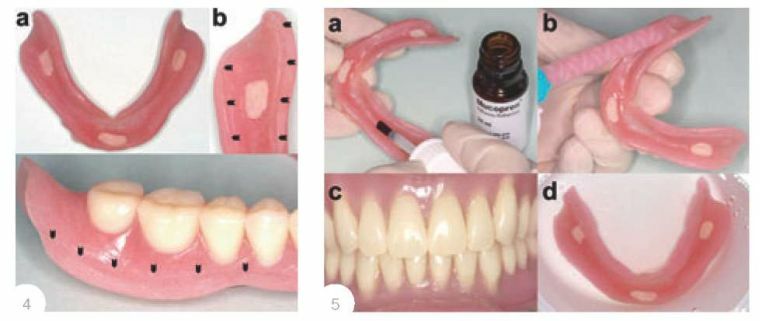
The undoubted advantage of this method is the ability to eliminate all the violations that occurred during one visit. The patient does not leave the office without teeth. But, unfortunately, the conditions of the dental clinic are inferior to laboratory ones. In the dental laboratory, the range of materials is wider, and the plastic itself is stronger.
When relining prostheses in the clinic, significant pressure on the oral mucosa is excluded to reduce the negative effect on the tissue.
As a result, air bubbles remain in the plastic, which cause its high porosity. Such designs lose their appearance more quickly, become dirty, change their color and become less durable.
At clinical relocation there is one more nuance about which it is impossible to forget. For a finer correction of the basis of the design in order to correct the patient's occlusion, the plastic must be sufficiently fluid and its consistency liquid. In this case, the toxic effect on the oral mucosa becomes even greater.
It is better to give preference to the laboratory method in the following cases:
- poor fixation of the prosthesis due to abnormalities at the manufacturing stages;
- in the manufacture of the first artificial teeth;
- with a decrease in occlusion height.
Procedure in the
laboratory After assessing the condition of the prosthetic elements and their location in the oral cavity, the doctor makes an accurate impression, which is then sent to the dental technician.
Stages:
- the preparation of the surface of the insertion structure takes place in the clinic by the same procedure, then the top layer of
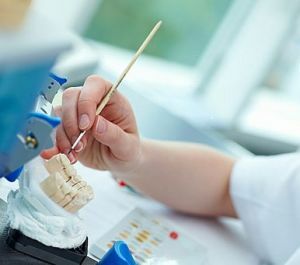 plastic 1 mm thick is removed;
plastic 1 mm thick is removed; - prosthesis with an impression is placed in a cuvette and filled with gypsum;
- then the impression material is removed, and the resulting gap is filled with plastic;
- further plasticizes;
- excess material is removed, and the surface of the product is polished.
The advantages of the laboratory method:
- absence of contact of the monomer with the mucous membrane of the oral cavity;
- full merge of a new layer of a material with old;
- the perfect aesthetics of the received design.
Disadvantages:
- is at risk of deterioration of product quality due to technical errors that can be tolerated at any stage of its manufacture;The patient should wait 2-3 days for the
- .
Some features of
Relocation with a decrease in the height of the occlusion has some features. In this case, it is always necessary to clarify the central 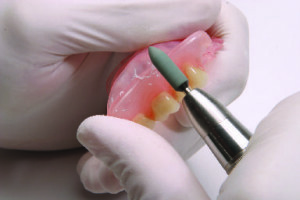 ratio of occlusion, since it can change as a result of the ongoing processes of atrophy. Especially it is expressed with direct prosthetics.
ratio of occlusion, since it can change as a result of the ongoing processes of atrophy. Especially it is expressed with direct prosthetics.
For clarification use a small layer of thermoplastic plastic, which is laid between the dentition. Then the doctor measures the height of the lower third of the face in a state of physiological rest and when it is closed. In this way, the optimal interocclusion gap in this case will be determined.
Next on the prosthesis is also applied the right amount of plastic and draw up its boundaries, using functional tests. At the end, the closure in the central occlusion position is checked again.
Used materials
For the removal of removable prostheses the following materials are used:
- Mollosil;
- Silagum AV Comfort;
- GC Coe-Soft;
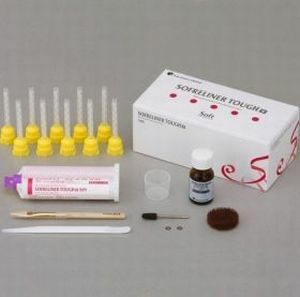
- GC Soft Liner;
- Rebase II;
- Sofreliner M Tough;
- Sofreliner S;
- Thixoflex.
Prostheses obtained as a result of relocation both in the clinic and in the dental laboratory, have a good fixation and correctly distribute the masticatory pressure on the tissues of the prosthetic bed. The period of adaptation to them is absent, since this is the same structure that was previously in the oral cavity.
